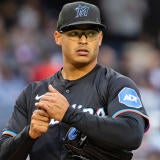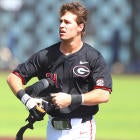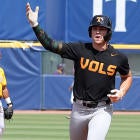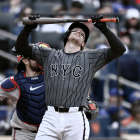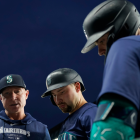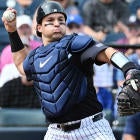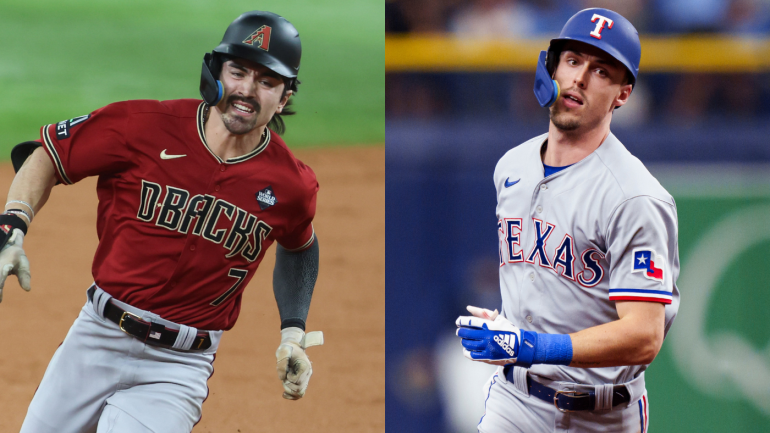
The World Series between the Texas Rangers and the Arizona Diamondbacks will continue on Tuesday night with Game 4 at Chase Field in Phoenix, Arizona. The best-of-seven series sits at 2-1 after the Rangers kept their perfect playoff road record intact on Monday night.
Understandably, there's been a lot of attention so far paid to the fact that the Rangers and Diamondbacks are just the fifth and sixth teams to ever reach the World Series within two years of a 100-loss season. Indeed, this is the first time in history that two such teams have faced off in the Fall Classic. But there's another common link that we feel merits attention -- that is, how both squads landed a franchise outfielder outside of the top half of the first round.
By now, you're probably familiar with Arizona's Corbin Carroll and Texas' Evan Carter. Carroll drove in two runs in each of the first two games of this series. Carter, meanwhile, established a few rookie records earlier this month. Nevertheless, allow us the time and space to break down each player's game, as well explain how, in retrospect, they were too low on draft boards.
Corbin Carroll, RF, Diamondbacks
Where was he drafted? Carroll was the 16th pick in 2019. He was selected after three other outfielders, in JJ Bleday, Riley Greene, and Hunter Bishop.
Why so low? Height. It sounds silly now, but Carroll is listed at 5-foot-10. Teams tend to be nervous about shorter players possessing enough power to make pitchers pay. The rise of ball- and bat-tracking technology might change that, enabling teams to better quantify and assess power potential. For now, though, it's fair to write that Arizona's general manager Mike Hazen and assistant GM Amiel Sawdaye have benefited from the obsession with height. Both were members of the Boston Red Sox's front office when Mookie Betts and Andrew Benintendi were drafted. If anyone can speak to how height doesn't project future output, slugging or otherwise, it's them.
What does he bring to the table? Again, you probably don't need us to tell you that Carroll is a very well-rounded player. We'll do it anyway. He hit .285/.362/.506 (134 OPS+) with 25 home runs, 10 triples, and 54 stolen bases (on 59 attempts) during the regular season. His contributions were worth an estimated 5.4 Wins Above Replacement, according to Baseball Reference.
Carroll possesses one of the most dynamic skill sets in the majors. His maximum exit velocity this season (113.8 mph) ranked 55th among qualifiers, ahead of some names you wouldn't have expected -- like, say, Fernando Tatis Jr., Eloy Jiménez, and Bo Bichette. He also ranked ninth in Statcast's sprint speed metric, clearing more than 30 feet per second.
CORBIN. CARROLL.
— MLB Pipeline (@MLBPipeline) October 28, 2023
The @Dbacks rookie ties it up with his first postseason triple: pic.twitter.com/Lq4Ro6Xmzk
Factor in how Carroll has a decent command of the strike zone and a good feel for making contact, and it's no wonder the Diamondbacks were willing to sign him to a nine-figure contract before he'd played in as many as 40 big-league games. He's well on his way to rendering that deal an absolute bargain.
If there is a knock on Carroll's game, it's his arm. Despite serving as Arizona's starting right fielder, he possesses what could be described as a left-field arm. Teams took advantage of him all season, running on more than half of their extra-base advancement opportunities on balls hit in his direction. The Diamondbacks will live with it given how much ground Carroll covers in right, but in an optimal defensive alignment he would likely be posted in left.
Evan Carter, LF, Rangers
Where was he drafted? Carter was the 50th pick (i.e. middle of the second round) in 2020.
Why so low? Limited exposure. Carter didn't partake much in the showcase circuit as a high-school player because he believed he was going to Duke. That, plus the COVID-19 pandemic shuttering amateur ball early in spring 2020, left teams without a ton of looks at him. The Rangers were roundly criticized (by us included) for their selection at the time, though mea culpas started to be issued once word spread from the scouts who had seen him that spring, and who insisted that he was not only a top-50 talent, but that he was what amounted to a hidden first-round talent. It just goes to show that such a thing still exists.
What does he bring to the table? Whereas Carroll is going to win the National League Rookie of the Year Award in a runaway decision, Carter won't factor into the American League's voting until next year. He debuted late in the season, taking his first big-league cuts on Sept. 8. It won't quite end up being 1-to-1, but Carter is going to enter next spring with nearly as many playoff games under his belt as regular season contests. He still hit .306/.413/.645 (182 OPS+) with five home runs and three steals over the course of 23 games.
Carter is another well-rounded talent. He has an outstanding command of the strike zone and he rarely offers at balls. To wit, his 9% chase rate was the lowest among players with 20-plus games played this season. No one else finished in the single digits. His 34.5% swing rate also ranked as the lowest, suggesting that he could stand to grow more aggressive as he matures.
Tha Carter: World Series edition. pic.twitter.com/cfYtsTdBF7
— Texas Rangers (@Rangers) October 28, 2023
Arguably the biggest question facing Carter's game is his power upside. His hardest-struck ball this season was recorded at 107.5 mph, putting him near the bottom of the majors in that respect. Carter is only 21 (he celebrated his birthday about a week prior to his big-league debut), and it's expected that he'll tack on strength as he matures. His approach could play a factor as well. Some talent evaluators have expressed the belief that he'll reach a point where he's more apt to ambush pitchers who take his patient approach for granted.
Otherwise, Carter is already a high-level performer on a potential championship team. What more could you want from a player this young?










